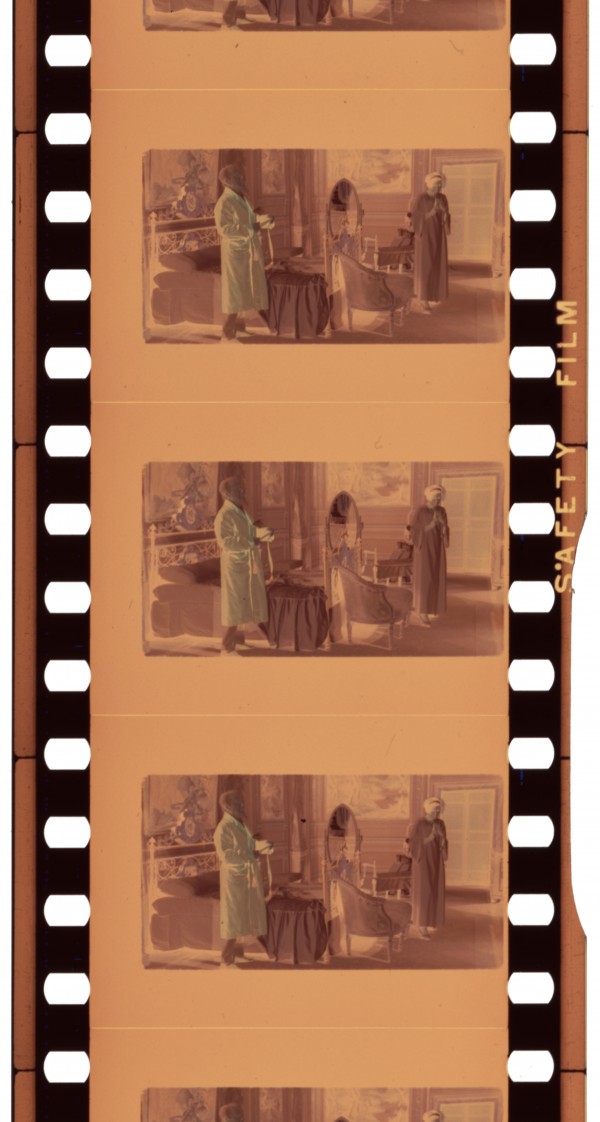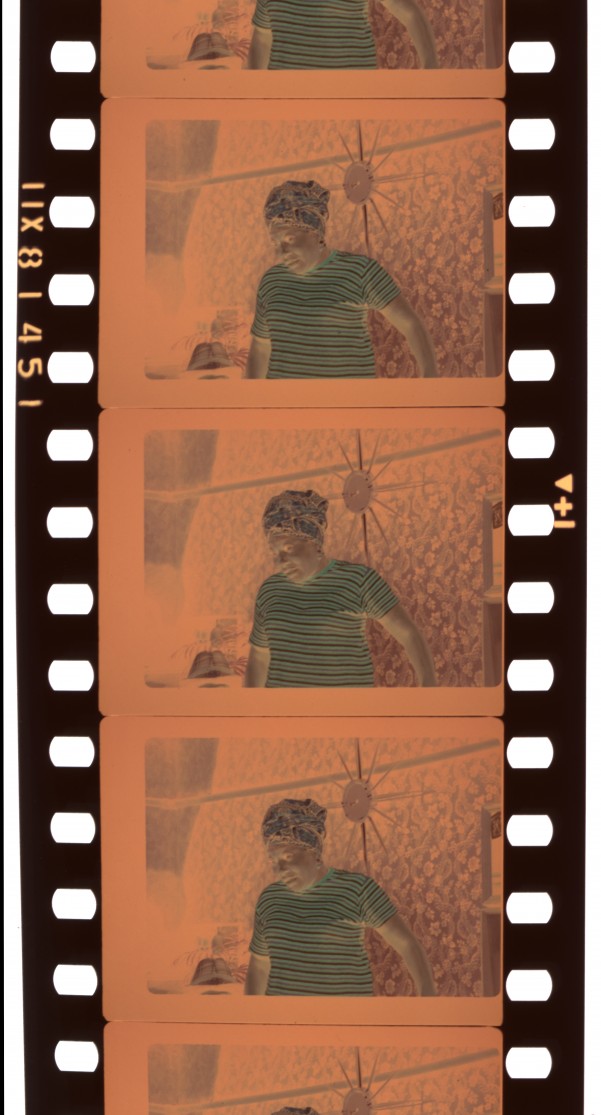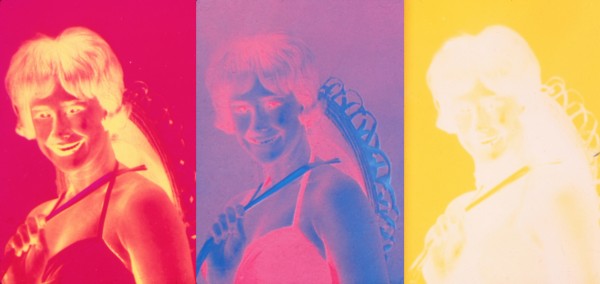Film Explorer

Color Reversal Intermediate (CRI) negative for Paul Morrissey’s Blood for Dracula (1974). Note the black edges and the edge numbers and stock information in yellow indicative of reversal film stock. As with colour camera negative, the orange masking is evident. The image is masked to 1.85:1 aspect ratio.
The Museum of Modern Art, New York, New York, United States.

Color Reversal Intermediate (CRI) negative for Melvin Van Peebles’ Don’t Play Us Cheap (1973). The edge number (left) and dating symbols (right) appear in yellow/orange text, and the edges of the film are black. The standard Eastman Kodak edge print symbols (+▲) date this film stock to 1973.
The Museum of Modern Art, New York, New York, United States.
Identification
History
Eastman Kodak’s Color Reversal Intermediate was a unique film designed to increase picture quality by eliminating the normal two-stage process for making duplicate negatives. Duplicate negatives were made to protect the original negative; provide negatives for foreign versions; create negatives for use in overseas markets; make trailers; and to carry out optical effects such as freeze frames and titles. Its use was widespread within the motion picture industry by the 1970s, on productions both small and large, across the World.
Color Reversal Intermediate was regarded as a major step forward in colour duplication on its introduction in 1968. In that year, the technology was awarded an Oscar® Class I Scientific or Technical Award.
Problems with image fade led to the withdrawal of the film in 1988. Indeed, in later years, it became apparent that many surviving CRIs were no longer usable due to this problem.
Selected Filmography
Technology
Color Reversal Intermediates were designed to replace the two-stage duplication process for making a colour duplicate negative. Traditionally, an interpositive was made, and from that a colour duplicate negative. The CRI was a one-stage duplicate negative made directly from the original negative. Whereas an original negative may contain hundreds of splices, a CRI typically has minimal splices, or is splice-free.
The one-stage printing with CRIs offered increased colour purity, decreased grain, leading to greater sharpness. However, the process was difficult to control, particularly if the process was only used intermittently; it was a complex process and, as with other colour reversal processes, it required two developing baths both of which had to be controlled accurately. Any deviation from the control standards could mean an inferior final print from the CRI negative. Uniformity of the image was also a problem with streaks being the result caused by uneven development, or insufficient agitation in the developer. The CRI process was like all other colour reversal processes but because it was used in a printing stage any faults were magnified when a print was made, this was caused by the required increase in contrast. As with all reversal films the exposure latitude is less than with negative/positive systems.
On the plus side, the process increased laboratory efficiency with the elimination of one stage of duplication. This elimination did require CRIs to be optically printed so that the normal printing geometry was maintained (so the image did not become flipped horizontally). To overcome this, and to avoid optical printing, some laboratories contact-printed the original negative through the emulsion (with the base of the camera negative in contact with the emulsion of the CRI), leading to a slight loss of sharpness.
CRI is easily identified by the black edges and black areas on unexposed film. The image is a colour negative, the tones are reversed as are the colours, so a red would appear as cyan, a white as black and low density areas such black would appear orange from the colour masking. It had a similar colour masking to colour negative. The masking improved colour reproduction by removing unwanted absorptions in the film dyes, leading to purer colours

Cross section of unprocessed Eastman Color Reversal Intermediate Film 5249/7249.
Anon. c.1968. Eastman Color Reversal Intermediate Film Processing Manual. Rochester: Eastman Kodak Company: CRI-1-202. Colored by Crystal Kui.

Magenta image with yellow mask and cyan image with magenta mask giving the overall orange colour to the negative image. The yellow image did not have a mask.
Images from a lecture by DR RWG Hunt, Kodak Research Laboratory, Kodak Ltd, Harrow, GB.
References
Beckett, Clark, Robert A. Morriss, Richard K. Schafer & J. Marvin Seemann (1968). “Preparation of Duplicate Negatives Using Eastman Color Reversal Intermediate Film”. Journal of the Society of Motion Picture and Television Engineers, 77: 10 (October): pp. 1053–1056.
Deer, P. L. & J. H. Donlon (1970). “Experience with Processing Color Reversal Intermediate Film 5249”. Journal of the Society of Motion Picture and Television Engineers, 79: 11 (November): pp. 1009–1010.
Haines, R. W. (2003). Technicolor Movies: The History of Dye Transfer Printing. Jefferson, NC: McFarland & Company.
(c. 1974). Eastman Color Reversal Intermediate Film. Hemel Hempstead: Kodak Limited Motion Picture Division.
(c. 1974). Schemes for Printing Eastman Color Films. Hemel Hempstead: Kodak Limited Motion Picture Division.
(c. 1970s). Color Reversal Intermediate Processing Manual. Hemel Hempstead: Kodak Limited Motion Picture Division.
Patents
None Found.
Related entries
Author
Brian Pritchard began his career at the Kodak Research Laboratories in 1962, working on X-Ray Fluorescence Analysis, followed by measuring Modulation Transfer Function of Films. He then moved to the Motion Picture Sales Department as a technician. In 1969, Pritchard moved to Filmatic Laboratories where he became Technical Director, moving to Humphries Laboratories in 1981 as Technical Director; and then in 1987 moved to Hendersons Film Laboratories. Brian became a consultant in 2002, including a number of years at the National Film Archive. He is the co-author of a book with David Cleveland, How Films Were Made and Shown: Some Aspects of the Technical Side of Motion Picture Film 1895–2015 (2015) and a contributor to the expanded edition of Harold Brown’s Physical Characteristics of Early Films as Aids to Identification (2020) and to the Journal of Film Preservation.
Pritchard, Brian (2024). “Eastman Color Reversal Intermediate”. In James Layton (ed.), Film Atlas. www.filmatlas.com. Brussels: International Federation of Film Archives / Rochester, NY: George Eastman Museum.


